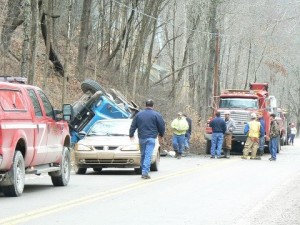Accidents Continue in Central West Virginia
From Reports of the Doddridge County Watershed Association
On WV Route 18 not far from West Union in Doddridge County, the recent truck accident was cleaned up and cleared. A tanker truck ran off the road and turned on its side, as shown in the picture at left. This location is near the Irwin Pad.
Also, at the Hill Pad on Indian Run Road near Salem in Harrison County, the drilling mud stored in frack tanks was discharged from a circulation hose when the circulation pump was turned on. In this case some 2100 gallons of low toxic drilling mud was discharged.
Information on the extent of contamination of the local soils and water streams by these recent accidents is not available at this time.
The Doddridge County Watershed Association continues to express concern for releases of contamination with potential to contaminate the local streams including Middle Island Creek, the source of water for West Union, the county seat of Doddridge County, WV.


{ 4 comments… read them below or add one }
The description of the drilling fluid seems strange at best, low toxic drill mud. Sounds like an attempt to downplay a serious issue. In the past weeks in the same area, involving I think the same operator, there has been a lot of environmental neglect. Lets see, a tanker truck with calcium carbonate [friction reducer] directly into the stream, 2100 gallons of drillfluid, plus a spill not long ago concerning the overflow of condensate into the stream. And, these are the ones reported.
I guess it doesn’t take much to imagine how many spills go without being reported, covered up and the environmental damages on top of the earth and deep below. There seems to be a serious lack of regulation and general disrespect for people and their land. These operators do not bring enough economic value to allow them to get away with anything. There are so many issues that need addressed before the next permit should be given.
I have mixed a lot of drilling fluid when working in the industry, some ingredients include caustic soda, dynadrill, calcium carbonate, large amounts of salt, polymers, and a lot of other chemicals and minerals such as wetting agents etc. None of these belong in our streams, so why throw around words like low toxicity. The fluid will still kill fish and the ecosystem; I wouldn’t want to drink it.
This is an example of industry downplaying it and anybody that disagrees they label as irrational. These issues must be addressed and now by us as a society. We need to come together on the environmental front and tell these companies how we feel and what we will not accept. The EPA needs to make huge efforts to see to it that any and all orphan wells be found and therefor plugged before hydrualic fracturing in that area. These things will provide jobs while helping the environment, and a sense of urgency is a must.
Calcium carbonate is not a friction reducer. By another name it is limestone, we put it on dirt roads for surfacing and pothole repair as crushed stone. Please, check your facts.
Calcium carbonate is sometimes mixed as an additive in drill fluid with friction reducers and anything like lime that affects viscosity will affect friction with an increase of drill cuttings that come up. Facts checked and it still spells environmental disaster. Thanks.
Actually there are lots of minerals like lime or barite to add weight/hydrostatic pressure, and graphite that is a friction reducer, dynadrill, etc. Along with minerals comes chemicals like caustic soda for pH control. All of which are alien substances hitting our streams. We can downplay and say things like limestone we put in potholes, salt in food, graphite in pencils. The fact is that these minerals/chemicals don’t belong in our drinking water. This is the point, having nothing to do with the particular uses which change from industry to industry.